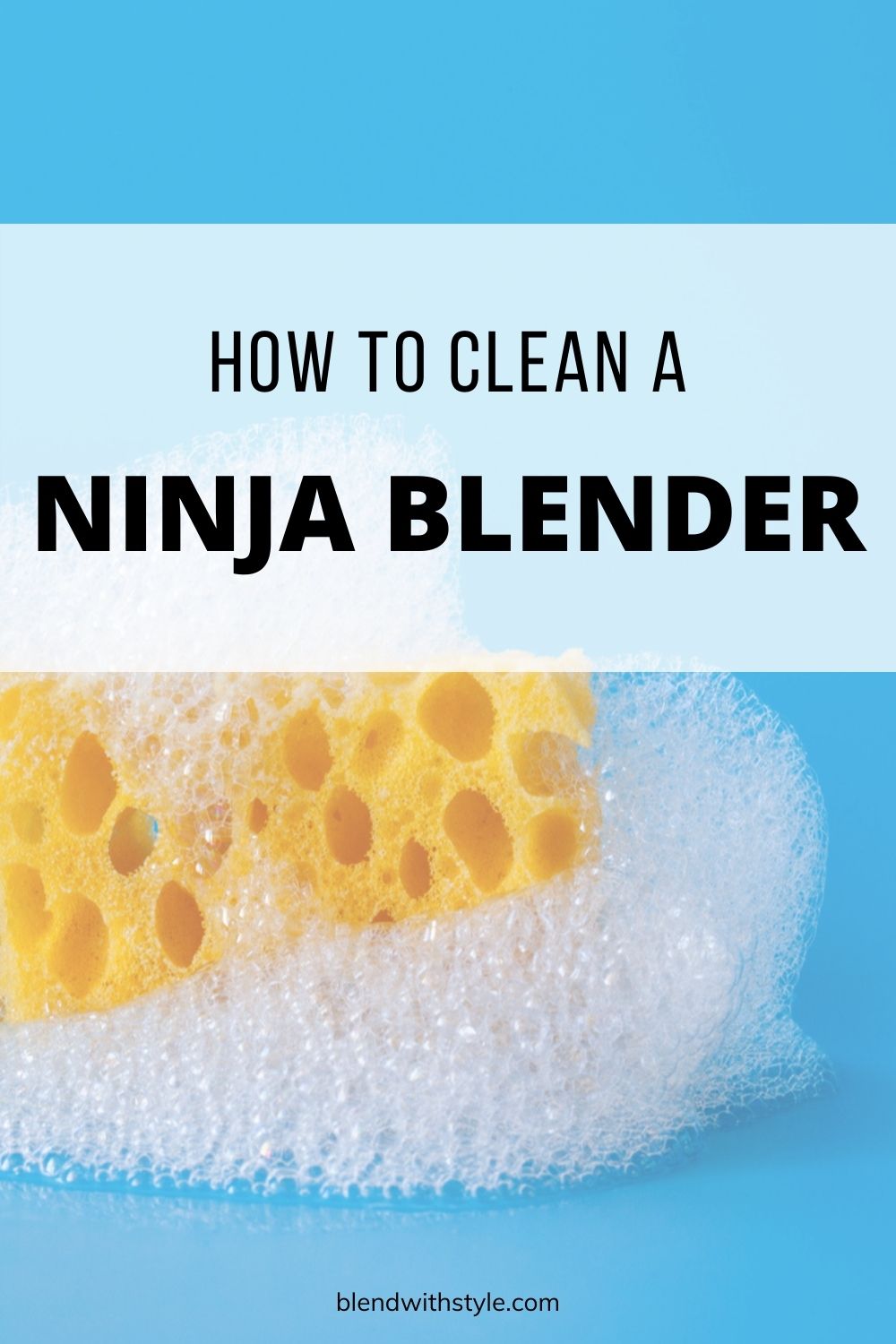Learning how to clean a Ninja blender can be intimidating! After all, these machines aren't called 'ninja' for nothing. Sharp blades, oddly shaped containers, and electrical components add to the intimidation factor.
However, cleaning your blender doesn't have to be scary. In fact, with our easy step by step guide, you'll have the task done in a flash.
All you need to get started is your dirty Ninja blender, a little dish soap, clean water, and some elbow grease. So, finish off that smoothie and let's get to work!

Getting Your Ninja Blender Clean
Ninja blenders are fantastic machines. They can crush, chop, grind, blend, and pulverize ingredients to make wonderful things to eat. However, after the meal prep is done, you are often left with a mess. To further complicate matters, that mess is often surrounded by sharp blades.
There are three methods that make cleaning your Ninja blender less of a chore and more of a quick, efficient part of your day. We'll walk through, in detail, each of the methods as well as the things that you may need to get the job done right the first time.
Washing a Ninja Blender by Hand
Washing your Ninja blender by hand is a very effective method for getting your blender back into service. Additionally, washing by hand is the main method if you live in a place without a dishwasher.
Before you begin washing, take some time to gather a few key items that you will need. After all, it's a total bummer to be standing in the kitchen half prepared while your smoothie melts slowly nearby. Consider collecting the following items:
- Your dirty Ninja blender
- The owner's manual of your blender
- Dish soap
- Bottle brush or sponge
- Drying rack
- Clean dish towel
1. Separate the blending container from the base
Separate the blending container from the blender base. Depending on the Ninja blender model that you have, this could mean twisting a container, lifting a cup, or rotating a large blending jar. This step is very important as the blending base (containing the electrical components) should never come in contact with water.
2. Disassemble the blending container and blades
Begin taking apart all of the removable parts of the blending container. This includes removing the lid, tamper, and blades. Use extreme caution when removing the blade assembly in order to avoid cuts and scrapes.
Notably, depending on how frequently you use your blender, you may not need to remove the blades each time you clean. Sometimes a quick rinse with some water is enough to clean your blending container between a morning smoothie and afternoon protein shake.
3. Wash all blender parts
Carefully begin washing all parts of the blending container using soap and warm water. It helps to use a bottle brush to thoroughly clean all the curves and edges of the container. Furthermore, using a bottle brush also aids in keeping your fingers away from the sharp blades.
If you have chosen to remove the blade assembly, clean carefully around each of the blades using a non-scratch sponge or bottle brush.
Finally, rinse the blades, lids, tamper, and container with warm water. Rinsing thoroughly may require a few passes underneath the water faucet in order to get all of the soap properly cleared. Again, take your time and always avoid the sharp blades.
4. Dry all blender parts
Using a clean dish towel, carefully dry each of the blender container parts. Take note to wipe any excess water that may be pooling in the bottom of a container in order to avoid bacteria growth.
Alternatively, you can also use a drying rack to let each part fully dry. Be sure to flip any blending container upside down, allowing for air flow to properly access all parts of the jar.
5. Wipe down the blender base
Before you begin this step, ensure that your blender base is unplugged. From here, using a damp cloth, gently wipe down the blender base to remove any spots or fingerprints. The blender base should never come in contact with water, but a damp cloth is safe to use without harming the blender.
6. Reassemble the blender
Now that everything has been properly washed and dried, it's time to reassemble to blender. Carefully place the blades back into place (if you have removed them) and re-join any lids or tampers with the container. From here, store everything in a convenient place until it's time to use your blender again.
Self Cleaning a Ninja Blender
Some Ninja blenders like the Ninja Foodi have self cleaning programs. All you need to do is fill the blending container with warm water, add a drop of soap, and press the program button. A magical blender dishwasher will appear before your eyes!
However, not every Ninja blender is equipped with a self cleaning program. It's something to be sad about, but there is good news. With some clever tricks, you can manipulate your Ninja to clean itself! Here's a list of things you may need in order to make this happen:
- Your dirty Ninja blender
- A drop of dish soap
- Clean dish towel
- Drying rack
1. Fill the blending container
Fill the blending container with water and a few drops of soap. Be sure not to overfill as you need to allow some room in the container for the blender to perform its magic cleaning cycle.
2. Place the blending container on blender base
Most importantly, do not forget to ensure that the lid of the container is secured tightly before you begin this step.
Carefully place the blending container onto the blender base. Depending on your unique Ninja model, this may mean twisting or rotating a container into place.
For some personal blender models, like the Nutri Ninja, it may mean seating the blending jar directly down onto the base.
3. Turn on the blender
Turn the blender on the lowest speed. For some personal models, you will need to press down on top of the blending cup in order to activate the motor. From here, slowly increase blender speed until you have created a dishwasher-like experience inside of the blending container.
Continue with the cleaning cycle until you feel satisfied. Usually, about thirty seconds will be sufficient. However, if you have blended thick ingredients like dough, pesto, or hummus, then a longer time may be required.
Furthermore, if soap, excessive bubbles, or leakage begin to appear, then switch off your blender immediately and pour some of the cleaning solution into a nearby sink. Return the blending container to the base and re-start your cleaning cycle.
4. Turn off the blender
Switch your blender to the off position (or remove hand pressure for personal models) and remove the blending container from the base.
5. Rinse the blending container
Carry the soap filled container to the nearest sink and rinse all parts thoroughly until no soapy residue remains. This step is important as a soapy smoothie will not be very pleasant.
6. Dry the blending container
Use a clean dish cloth to dry the outside and inside of the blending container. As always, be careful to avoid the blades when drying your blending jar or cup by hand. You can also place your blending container on a drying rack to finish drying if drying by hand isn't your thing.
7. Gently wipe down the blender base
The blender base should absolutely never come into contact with water as this will destroy all of the electrical components inside. Instead, unplug the base and use a damp cloth to wipe down the outside of the blender base. Gently run the cloth over any buttons for further cleaning.
Once your blending container is fully dry, reunite it with any lids or special accessories and store it away, along with the blender base, for your next use.
Washing a Ninja Blender in the Dishwasher
Washing a Ninja blender in the dishwasher is by far the easiest cleaning method in our guide. This method is fairly straightforward, but does have one caveat in that not all Ninja models are dishwasher safe.
Before you attempt this cleaning method, always check the owner's manual that came with your blender to ensure that the model you have is able to be placed inside the dishwasher. After all, there is nothing worse than melted blender parts.
Here's what you need to get started:
- Your dirty Ninja blender
- A dishwasher
- Dishwasher detergent
1. Rinse the blending container
Before placing your blending container into the dishwasher, give it a quick rinse under some warm water. This helps to remove any large pieces of food still stuck in the blending jar.
Admittedly, if you have an incredibly powerful dishwasher, then this step is optional. You can also skip this step if you have only blended light ingredients like protein shakes or smoothies.
2. Disassemble the blending container
Carefully take apart the blending container. This means removing the lids, tamper, and blade assembly. Be sure to exercise extreme caution when handling the blade assembly.
3. Place all blender container parts in the dishwasher
Load the top rack in your dishwasher with all of the blender container parts. Usually, the top rack of a dishwasher is the safest place for these items as it helps prevent melting.
Furthermore, be careful how you arrange the blade assembly just in case you aren't ready to run the dish cycle immediately. It's never fun to be surprised by sharp blades while loading dishes!
4. Run the dishwasher cycle
Ensure your dishwasher is equipped with dishwasher detergent, then start the cycle.
5. Clean the blender base
While the dishwasher cycle is active, unplug the blender base and use a damp cloth to gently wipe down any messes.
If needed, use a mild multi-surface spray cleaner like Mrs. Meyer's Clean Day to help remove any stubborn or stuck on food particles.
Most importantly, never submerge or expose the blending base to excessive liquid as this could ruin your blender.
6. Unload the dishwasher
When the dishwasher has finished its job, carefully remove all blender container parts. Ensure that all parts have been thoroughly dried in the dish drying cycle. Alternatively, wipe all parts dry with a clean dish cloth.
7. Reassemble the blending container
Place all blending container parts back together and store your squeaky clean blender in a nearby cabinet or countertop.
Conclusion
Ninja blenders are some of the best blenders on the market. Using our guide, it's easy to keep your blender clean and tidy. Additionally, a blender that is well cared for is likely to last for many years saving both time and money.
By utilizing our cleaning instructions, you have a strong chance of elevating your blender cleaning game to new levels. Drop us a comment and let us know how this guide worked for you as well as some of your other favorite blender washing techniques. Happy blending!



